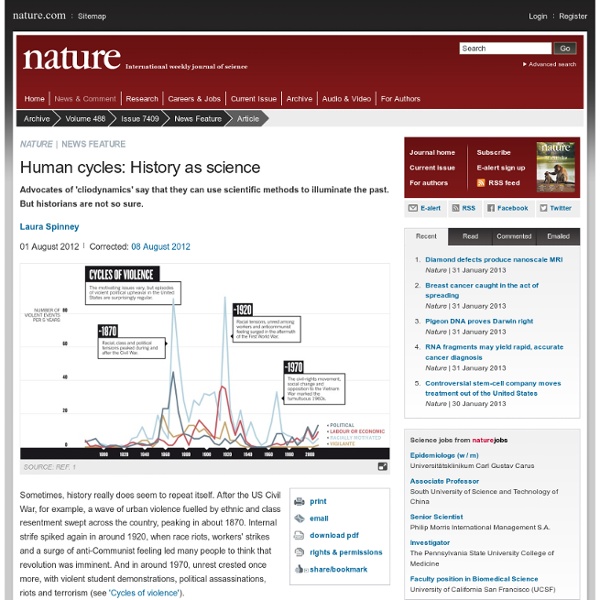The History and Geography of Inventions
[Home Page][Other Page] [Search Inventions] [Before 10,000 BC][10,000 BC to 4000 BC][4000 BC to 3000 BC][3000 BC to 2000 BC][2000 BC to 1000 BC][1000 BC to 1 BC][1 AD to 1000 AD][1000 to 1500][1500 to 1700][1700 to 1800][1800 to 1850][1850 to 1900][1900 to 1950][Since 1950] [Inventions][Biographies][Religions of the World][Bible Contradictions][Rain][Countries of the World][Cookery][Music][Composers (Opera)] [Readers' Feedback (Religion)] [Language][Travel][Eclipses][London][Astronomy][Mathematics][Physics][Chemistry][Biology][Football][Television][Other] Sponsored Link
History's Most influential people ranked by wiki reach
This article was taken from the November 2012 issue of Wired magazine. Be the first to read Wired's articles in print before they're posted online, and get your hands on loads of additional content by subscribing online. This infographic reveals the world's most influential people, born before 1950, using data from all language editions of Wikipedia. Rankings are based on parameters such as the number of language editions in which that person has a page, and the number of people known to speak those languages (L/BN). Using this quantitative approach, Hidalgo is now testing hypotheses such as whether cultural development is structured or random. View the full-size image in our gallery
Eshnunna
Coordinates: 33°29′3″N 44°43′42″E / 33.48417°N 44.72833°E / 33.48417; 44.72833 Eshnunna (modern Tell Asmar in Diyala Province, Iraq) was an ancient Sumerian (and later Akkadian) city and city-state in central Mesopotamia. Although situated in the Diyala Valley north-east of Sumer proper, the city nonetheless belonged securely within the Sumerian cultural milieu. The tutelary deity of the city was Tishpak (Tišpak). History[edit] Occupied from the Jemdet Nasr period about 3000 BC, Eshnunna was a major city during the Early Dynastic period. After rising to prominence as an independent state in the early second millennium, during the time of Shamshi-Adad, Eshnunna was occupied by Elam, then conquered by Hammurabi of Babylon in the 38th year of his reign, and absorbed within the Old Babylonian Empire (sometimes called the First Babylonian Dynasty). Archaeology[edit] In the late 1990s, Iraqi archaeologists worked at Tell Asmar. Laws of Eshnunna[edit] Square Temple of Abu[edit] Notes[edit]
Retronaut - See history.
1901 to World War II
A moving story: with afterword - Jocelyn Cohn and James Frey
In 2012, workers at a small moving company in New York City rose up against bad pay and dangerous work conditions. In the course of the struggle, much was revealed about how exploitation operates; how the enticements of 'self-expression' and a 'laid back' atmosphere serve to weaken consciousness and collective action. At the same time, this history reveals the opportunities and limits that workers face within self-organized struggles in a small business format. In the Summer of 2012 the exploited workers at Rabbit Movers autonomously organized our shop and began the fight for control over the conditions of our lives. “They Just Run Us Into The Ground...” Our struggle was born in the cabs of box trucks all over the city. Work in our shop comes in a pattern of feast or famine. “My Mover Has Read Goethe!” We have all worked plenty of “shit jobs” before and came to this company with no illusions about the nature of precarious work in the present day. “My mover has read Goethe!”
ancient maps
home page Down to: 6th to 15th Centuries | 16th and 19th Centuries | 1901 to World War Two | 1946 to 21st Century The Ancient World ... index of places Aegean Region, to 300 BCE Aegean Region, 185 BCE Africa, 2500 to 1500 BCE Africa to 500 CE African Language Families Alexander in the East (334 to 323 BCE) Ashoka, Empire of (269 to 232 BCE) Athenian Empire (431 BCE) China, Korea and Japan (1st to 5th century CE) China's Warring States (245 to 235 BCE) Cyrus II, Empire of (559 to 530 BCE) Delian League, 431 BCE Egyptian and Hittite Empires, 1279 BCE Europe Fertile Crescent, 9000-4500 BCE Germania (120 CE) Greece (600s to 400s BCE) Gupta Empire (320 to 550 CE) Han China, circa 100 BCE Hellespont (Battle of Granicus River, 334 BCE) India to 500 BCE Israel and Judah to 733 BCE Italy and Sicily (400 to 200 BCE) Judea, Galilee, Idumea (1st Century BCE) Mesopotamia to 2500 BCE Mesoamerica and the Maya (250 to 500 CE) Oceania Power divisions across Eurasia, 301 BCE Roman Empire, CE 12 Roman Empire, CE 150 Roman Empire, CE 500
BEFORE THEY PASS AWAY
The purity of humanity exists. It is there in the mountains, the ice fields, the jungle, along the rivers and in the valleys. Jimmy Nelson found the last tribesmen and observed them. He smiled and drank their mysterious brews before taking out his camera. He shared what real people share: vibrations, invisible but palpable. He adjusted his antenna to the same frequency as theirs. There is a pure beauty in their goals and family ties, their belief in gods and nature, and their will to do the right thing in order to be taken care of when their time comes. ‘’In 2009, I planned to become a guest of 31 secluded and visually unique tribes. Elegant and evocative portraits created with a 4x5 camera. THE BOOK - XXL LIMITED EDITION 500 exclusive and numbered copies of this XXL book, offered in a sumptuous clamshell box, showcased on a custom-made transparent book holder and containing three autographed art prints. Purchase›



